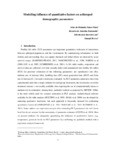Please use this identifier to cite or link to this item:
http://www.alice.cnptia.embrapa.br/alice/handle/doc/968632| Title: | Modelling influence of quantitative factors on arthropod demographic parameters. |
| Authors: | MAIA, A. de H. N.  PAZIANOTTO, R. A. A.   LUIZ, A. J. B.   PERVEZ, A.   |
| Affiliation: | ALINE DE HOLANDA NUNES MAIA, CNPMA; RICARDO ANTONIO ALMEIDA PAZIANOTTO, CNPMA; ALFREDO JOSE BARRETO LUIZ, CNPMA; AHMAD PERVEZ, Govt. Degree College. |
| Date Issued: | 2013 |
| Citation: | In: REUNIÃO ANUAL DA REGIÃO BRASILEIRA DA SOCIEDADE INTERNACIONAL DE BIOMETRIA, 58.; SIMPÓSIO DE ESTATÍSTICA APLICADA À EXPERIMENTAÇÃO AGRONÔMICA, 15., 2013, Campina Grande. Modelagem estatística em áreas multidisciplinares: impactos causados pelas mudanças climáticas na Região Nordeste: anais. Campina Grande: Sociedade Internacional de Biometria, 2013. 7 p. |
| Description: | Fertility life table (FLT) parameters are important quantitative indicators of interactions between arthropod population and the environment. By summarizing information on both fertility and survivorship, they can capture chronicle sub lethal effects not detected by acute survival assays (MARINHO-PRADO, 2011; NASCIMENTO et al., 1998; NARDO et al (2001) LIU et al, 2005; LUMBIERRES et al, 2004). In life table studies, oviposition and survival data are collected over time (usually daily) and summarized into fertility life tables (FLT) for posterior estimation of the following parameters: net reproductive rate (Ro), intrinsic rate of increase (Rm), doubling time (DT), mean generation time (MGT) and finite rate of increase ( ), for each o treatments evaluated. As FLT parameters summarize data from experimental units into a single estimate for each group (treatment), the information on within treatment variance is not readily available, thus requiring the use of computationally intensive methods for its estimation. Among them, jackknife method, as proposed by MEYER (1986), is the most widely used for variance estimation in FLT analysis. Jacknife-based software available for life table analysis (HULTING et al, 1990 ; MAIA et al, 2000) was developed for analysing qualitative treatments, but such approach is frequently misused for contrasting quantitative factors (GANJISAFFAR et al., 2011; PAKYARI et al., 2011; RAZMJOU et al., 2011). Some authors use regression analysis after estimating FLT parameters for each factor level but do not account for the uncertainty of parameter estimates (CONTI et al, 2010). Here we present methods for adequately quantifying the influence of quantitative factors (e.g. temperature, pesticide level) on FLT parameters by combining the jackknife method with a regression analysis framework. |
| Thesagro: | Inseto Dinâmica populacional Modelo matemático Análise estatística Arthropoda |
| NAL Thesaurus: | Population dynamics Insects |
| Keywords: | Jackknife method Fertility life tables Artropoda |
| Type of Material: | Artigo em anais e proceedings |
| Access: | openAccess |
| Appears in Collections: | Artigo em anais de congresso (CNPMA)  |
Files in This Item:
| File | Description | Size | Format | |
|---|---|---|---|---|
| 2013AA56.pdf | 147,61 kB | Adobe PDF |  View/Open |









